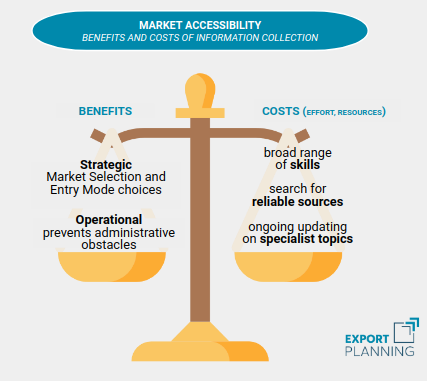"International Market Accessibility" (IMA): Quarterly Wrap-Up
Published by Valeria Minasi. .
Planning Internationalisation Export Foreign markets International marketing Market Accessibility
Log in to use the pretty print function and embed function.
Aren't you signed up yet?
signup!
The Market Accessibility1 section of ExportPlanning magazine goes on vacation, not before briefly summarizing in this article the topics covered in recent months.
We have first of all tried to make people understand how the accessibility analysis is a key step for any internationalization project, both in terms of strategic choices and implementation2.
At the same time, we have highlighted how the information collection phase of market accessibility may require a very wide range of competencies and knowledge on specialized topics.
MARKET ACCESSIBILITY INFORMATION COLLECTION:
an essential activity,
but characterized by high economies of scale

In line with this consideration, in the articles of the Market Accessibility section some case studies concerning particular country/market combinations have been documented, for which it is necessary to pay attention in order to avoid strategy mistakes.
MARKET ACCESSIBILITY: regulatory news, document requirements and product labelling ...
One of the sectors on which we have particularly focused is the agri-food sector. We have seen that there are certainly excellent market opportunities but, at the same time, we have also reported the elements that need to be taken care of in order to consciously address the issue of barriers to entry.
We have addressed, for example, the accessibility of the Swiss market for quality wines3. In terms of market accessibility requirements, Switzerland does not present major problems, but it is worth mentioning some important indications, some of which are of a tariff-protectionist nature, others of a documentary nature.
With regard to food exports to the USA, however, we have addressed both the issue of correct labelling and the special conditions of accessibility for low-acid canned products4.
About labelling5, it is regulated by the FDA (CFR 21.1011). The standard establishes a type of labelling totally different from the EU one for the positioning of the information and its relative importance (e.g. Nutrition Facts). The reason for this diversity is to be found in the different needs of the American consumer (and consequently of the Authorities in charge)6.
...regulations Dual Use, embargoes and secondary sanctions ...
In addition to sector inquiries, we have had the opportunity to present some cross-cutting themes. We have addressed the Dual Use topic, which identifies those goods and technologies which, although mainly used for civil purposes, can be used in the manufacture and development of different types of armaments. The export of dual goods and technologies7 is governed by a variety of regulations and procedures that meet national and international security requirements8.
We have also discussed about the US secondary sanctions9, which affect not only the countries directly concerned, but also partners who want to do business with these countries, exploring some of the sanctions applied to companies involved in business with Iran.
In other cases, finally, the existence of particular barriers for some sectors can become an opportunity for development for others: this is the case of Russia, where the embargo for agri-foodstuffs has been an opportunity to relaunch the industry of machinery and plants for the food sector10; also in this case the accessibility requirements of the Russian market11 have been highlighted - in addition to the elements of opportunity.
...and opportunities from Free Trade Agreements.
We also wrote about cured meat sector in Canada12, which is on the "short-list" of the markets with the highest potential in the ExportPlanning ranking. The sector offers significant opportunities to Italian and European exporters in general, both for the growing demand for products and for the conditions of access to the market, made even more interesting by the CETA agreement. Nevertheless, it is necessary that exporters who decide to approach this market are well informed about the requirements and documents necessary for the correct application of the regulations in force.
We also mentioned the opportunities that a careful analysis of accessibility can open up. This is the case with the export of consumer goods to Hong Kong13. Hong Kong is at the top of the world market rankings for per capita import levels of quality consumer goods, i.e. in the highest price ranges. Despite the current tensions in relations with China, the Closer Economic Partnership Arrangement (CEPA) signed on 29 June 2003 (and subject to subsequent improvements over the years) is in force between the two economies. It is also recalled that since 2018 an agreement on the automatic exchange of financial information between Italy and Hong Kong has been in force, in order to facilitate investments in this country.
In addition, we have dealt with the new agreement between the EU and Vietnam (EVFTA)14, which entered into force only a few days ago (August 1, 2020), offering new opportunities to the whole health sector.
Appointment after the summer break
for the next IMA articles:... "stay-tuned" !
After the summer break, we are planning to discuss new issues related to market accessibility, which may allow, on the one hand, to strategically approach a market and, on the other hand, to prevent possible administrative obstacles.


